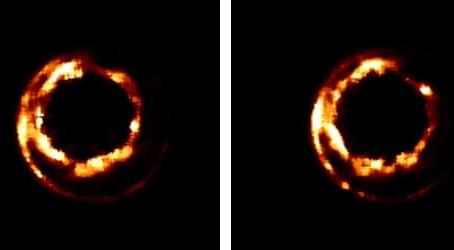Characterized by just three parameters—mass, spin, and charge—black holes could be considered one of the Universe’s simpler astrophysical objects. Yet, the number of open problems related to how the dark behemoths behave also marks them as one of the most enigmatic. One puzzle is why the plasma around black holes glows so brightly. Now, in 3D simulations of the magnetic fields within this plasma, Benjamin Crinquand of Princeton University and colleagues think they have found the answer: the breaking and reconnecting of magnetic-field lines [1]. The simulations predict that, under certain conditions, magnetic-field instabilities can induce radio-wave hot spots that rotate around the shadow of the black hole. This prediction could be tested by future versions of the Event Horizon Telescope (EHT)—the network of radio dishes used to capture the first black hole images (see Research News: First Image of the Milky Way’s Black Hole).
There are several mechanisms that physicists think could be behind a black hole’s light. One of those is so-called accretion power, where friction-like forces in the infalling plasma heat the plasma, leading to the emission of photons. Models of this process predict constant emission signals, which doesn’t seem to fit with observations of high-intensity bursts of gamma rays from black holes.
Another possibility—and the one that Crinquand and his colleagues consider—is that the energy needed to create this light is extracted from the magnetic field that threads through the plasma. When the lines associated with this field break apart and then reconnect—a process known as magnetic reconnection—magnetic-field energy can convert into plasma-kinetic energy that is then emitted as photons. This model would not replace the accretion one, but act in tandem with it.
